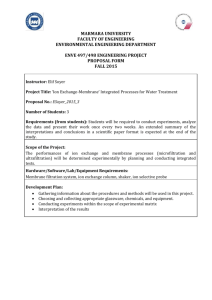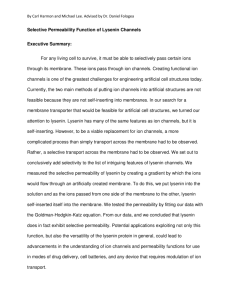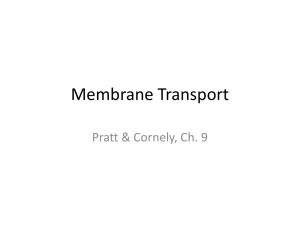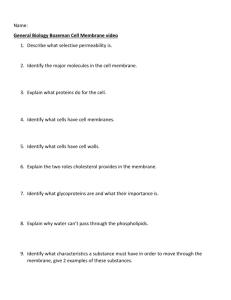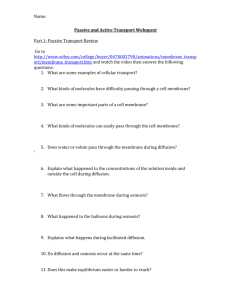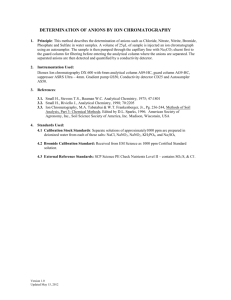Ppt file
advertisement
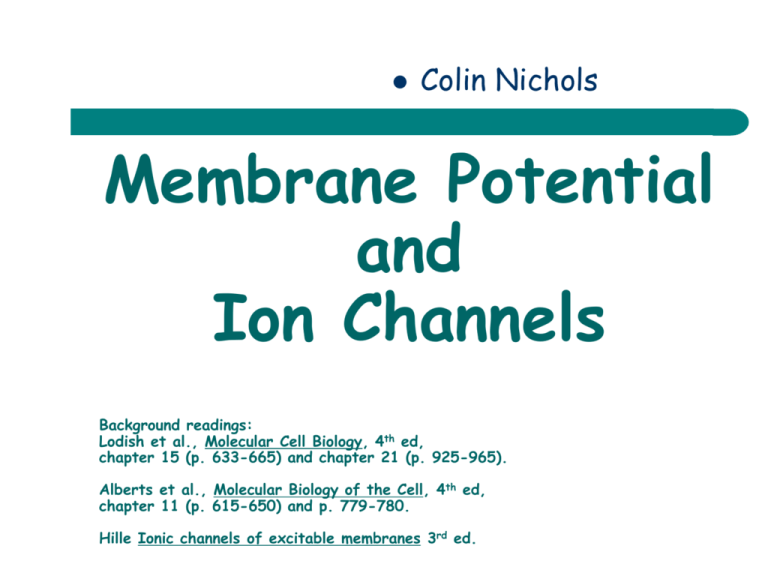
Colin Nichols
Membrane Potential
and
Ion Channels
Background readings:
Lodish et al., Molecular Cell Biology, 4th ed,
chapter 15 (p. 633-665) and chapter 21 (p. 925-965).
Alberts et al., Molecular Biology of the Cell, 4th ed,
chapter 11 (p. 615-650) and p. 779-780.
Hille Ionic channels of excitable membranes 3rd ed.
LIFE – A complex interplay of chemistry and physics
The action potential – Physics in cell biology
1
2
2
1
3
4
Na+
K+
3
4
Excitation-contraction coupling
The islet of Langerhans
Glucose-dependent hormone secretion
The Lipid Bilayer is a Selective Barrier
inside
outside
hydrophobic molecules (anesthetics)
gases (O2, CO2)
small uncharged polar molecules
large uncharged polar molecules
Ions
charged polar molecules (amino
acids)
water
Ion Channel Diversity
Cation channel Subunit Topology
Cation channel Subunit Topology
The ‘inner core’ of cation
channel superfamily
members
Structure of a Potassium Channel
Doyle et al., 1998
Selectivity Filter and Space-Filling Model
Doyle et al., 1998
Ion selectivity filter in KcsA
Doyle et al., 1998, Zhou et al., 2002
Selectivity filter diversity
Ion selectivity filter in Na channels
NavMs, NavAb, Kv1.2
Nature Communications , Oct 2, 2012. Structure of a bacterial voltage-gated sodium channel
pore reveals mechanisms of opening and closing Emily C McCusker,1, 3, Claire Bagnéris,1 Claire E
Naylor,1, Ambrose R Cole,1 Nazzareno D'Avanzo,2, 4 , Colin G Nichols2, & B A Wallace1
Views of the Channel Open and Shut
Jiang et al., 2002
Views of the Channel Open and Shut
Nature Communications , Oct 2, 2012. Structure of a bacterial voltage-gated sodium channel
pore reveals mechanisms of opening and closing Emily C McCusker,1, 3, Claire Bagnéris,1 Claire E
Naylor,1, Ambrose R Cole,1 Nazzareno D'Avanzo,2, 4 , Colin G Nichols2, & B A Wallace1
Ion gradients and membrane potential
Ion gradients and membrane potential
Ion gradients and membrane potential
Ion gradients and membrane potential
The inside of the cell
is at ~ -0.1V with
respect to the outside
solution
-89 mV
How does this membrane potential come about?
Ion gradients and membrane potential
K Na
Cl
K
-89 mV
How does this membrane potential come about?
Ion gradients and membrane potential
Na
117
K
3
Cl
120
Anions 0
Total 240
[+ charge] = [- charge]
0 mV
Na
30
K
90
Cl
4
Anions 116
Total
240
[+ charge] = [- charge]
-89 mV
How does this membrane potential come about?
Movement of Individual K+ ions
Na
117
K
3
Cl
120
Anions 0
Total 240
+
+
[+ charge] = [- charge]
0 mV
-
Na
30
K
90
Cl
4
Anions 116
Total 240
[+ charge] = [- charge]
0 mV
Movement of Individual Cl- ions
Na
117
K
3
Cl
120
Anions 0
Total 240
+
+
[+ charge] = [- charge]
0 mV
-
30
- Na
K
90
Cl
4
Anions 116
Total 240
[+ charge] = [- charge]
-89
0 mV
Setting a membrane potential –
questions!
How many ions must cross the
membrane to set up this membrane
potential?
What makes it stop at this potential?
Capacitance
Capacitance C
C=Q/V
Coulombs / Volt
Q=C*V
Farads
I = dQ / dt = C * dV / dt
C µ area
I
+
V
-
{
++++++++
- - - - - - - -
C
C µ 1 / thickness
For biological membranes:
Specific Capacitance = 1 µF / cm2
How many ions?
How many ions must cross the membrane of
a spherical cell 50 µm in diameter (r = 25
µm) to create a membrane potential of –89
mV?
Q (Coulombs) = C (Farads) * V (Volts)
Specific Capacitance = 1.0 µFarad / cm2
Surface area = 4 p r2
Faraday’s Constant = 9.648 x 104 Coulombs / mole
Avogadro’s # = 6.022 x 1023 ions / mole
Calculations
Area = 4 p r2
1
= 4 p (25 x 10-4 cm)2
= 7.85 x 10-5 cm2
= 78.5 x 10-6 µFarads
Q=C*V
2
= 78.5 x 10-12 Farads * 0.089
Volts
= 7 x 10-12 Coulombs
= 78.5 x 10-12 Farads
~ 7 x 10-12 Coulombs / 9.65 x 104 Coulombs per mole
3
= 7.3 x 10-17 moles of ions must cross the membrane
= 0.073 femptomoles or ~ 44 x 106 ions
~ 1.1 µM change in [ ]
Why does it stop?
- The Nernst Equation
Calculates the membrane potential at which an ion will
be in electrochemical equilibrium.
At this potential: total energy inside = total energy
outside
Electrical Energy Term: zFV
Chemical Energy Term: RT.ln[Ion]
Z is the charge, 1 for Na+ and K+, 2 for Ca2+ and Mg2+, -1 for ClF is Faraday’s Constant = 9.648 x 104 Coulombs / mole
R is the gas constant = 8.315 Joules / °Kelvin * mole
T is the temperature in °Kelvin
Nernst Equation Derivation
zF.Vin + RT.ln [K+]in = zF.Vout + RT.ln [K+]out
zF (Vin – Vout) = RT (ln [K+]out – ln [K+]in)
EK
= Vin – Vout
= (RT/zF).ln([K+]out/[K+]in)
EK = 2.303 (RT / F) * log10([K+]out/[K+]in)
In General:
Eion ~ 60 * log ([ion]out / [ion]in) for monovalent cation at 30°
Nernst Potential Calculations
First K and Cl
EK = 60 mV log (3 / 90) = 60 * -1.477 = -89 mV
ECl = (60 mV / -1) log (120 / 4) = -60 * 1.477 = -89 mV
Both Cl and K are at electrochemical equilibrium at -89
mV
Now for Sodium
ENa = 60 mV log (117 / 30) = 60 * 0.591 = +36 mV
When Vm = -89 mV, both the concentration gradient and
electrical gradient for Na are from outside to inside
At Electrochemical Equilibrium:
The concentration gradient for the ion is
exactly balanced by the electrical gradient
There is no net flux of the ion
There is no requirement for any energydriven pump to maintain the concentration
gradient
Ion Concentrations
Na
117
K
3
Cl
120
Anions 0
Total 240
[+ charge] = [- charge]
0 mV
Na
30
K
90
Cl
4
Anions 116
Total 240
[+ charge] = [- charge]
-89 mV
Ion Concentrations
Add water – 50% dilution
Na
117
K
3
Cl
120
Anions 0
Total 240
[+ charge] = [- charge]
0 mV
Na
30
K
90
Cl
4
Anions 116
Total 240
[+ charge] = [- charge]
-89 mV
Environmental Changes: Dilution
H2O
Add water – 50% dilution
Na
58.5
K
1.5
Cl
60
Anions 0
Total 120
[+ charge] = [- charge]
Na
30
K
90
Cl
4
Anions 116
Total 240
[+ charge] = [- charge]
-89 mV
Environmental Changes: Dilution
Add water – 50% dilution
Na
58.5
K
1.5
Cl
60
Anions 0
Total 120
[+ charge] = [- charge]
EK = -107 mV
ECl = -71 mV
Na
30
K
90
Cl
4
Anions 116
Total 240
[+ charge] = [- charge]
-89 mV
Environmental Changes: Dilution
H2O
Add water – 50% dilution
Na
58.5
K
1.5
Cl
60
Anions 0
Total 120
[+ charge] = [- charge]
EK = -107 mV
ECl = -71 mV
Na
30
K
<90
Cl
<4
Anions 116
Total <240
[+ charge] = [- charge]
-89 mV
Deviation from the Nernst Equation
The Goldman, Hodgkin, Katz
equation provides a better
description of membrane
potential as a function of
potassium concentration
in cells.
Squid Axon
Curtis and Cole, 1942
Resting Potential (mV)
Resting membrane potentials
in real cells deviate from the
Nernst equation, particularly
at low external potassium
concentrations.
0
-25
PK : PNa : PCl
1 : 0.04 : 0.05
-50
-75
EK (Nernst)
-100
1
3
10 30 100
External [K] (mM)
300
The Goldman Hodgkin Katz Equation
PK [K]out PNa [Na]out PCl [Cl] in
Vm 60mV log
PK [K]in PNa [Na]in PCl [Cl] out
Resting Vm depends on the concentration gradients and on the
relative permeabilities to Na, K and Cl. The Nernst Potential
for an ion does not depend on membrane permeability to that
ion.
The GHK equation describes a steady-state condition, not
electrochemical equilibrium.
There is net flux of individual ions, but no net charge
movement.
The cell must supply energy to maintain its ionic gradients.
GHK Equation: Sample Calculation
Suppose PK : PNa : PCl = 1 : 0.1 : 1
3 11.7 4
Vm 60mV log
90 3 120
= 60 mV * log (18.7 / 213)
= 60 mV * -1.06
= -63 mV
Recording Membrane Potential
To here L1
On-Cell Patch Recording (Muscle)
50 µm
Forming a Tight Seal
Whole-Cell and Outside-Out Patch
10 µm
Channels Exist in at least 2
States
To here…
Current ~3.2 pA
= 3.2 x 10-12 Coulombs/sec
Charge on 1 ion
~1.6 x 10-19 Culombs
Ions per second
= 3.2/1.6 x 10^7
~20 million
Exponential Distribution of Lifetimes
mean open time = topen = 1 / a = 1 / closing rate constant
Summary:
I.
II.
III.
Cell membranes form an insulating barrier that
acts like a parallel plate capacitor (1 µF /cm2)
Ion channels allow cells to regulate their volume
and to generate membrane potentials
Only a small number of ions must cross the
membrane to create a significant voltage
difference
~ bulk neutrality of internal and external solution
IV.
Permeable ions move toward electrochemical
equilibrium
•
•
Eion = (60 mV / z) * log ([Ion]out / [Ion]in) @ 30°C
Electrochemical equilibrium does not depend on
permeability, only on the concentration gradient
Summary (continued):
V.
The Goldman, Hodgkin, Katz equation gives the
steady-state membrane potential when Na, K and Cl
are permeable
PK [K]out PNa [Na]out PCl [Cl] in
Vm 60mV log
PK [K]in PNa [Na]in PCl [Cl] out
•
In this case, Vm does depend on the relative permeability to
each ion and there is steady flux of Na and K
The cell must supply energy to maintain its ionic
gradients
